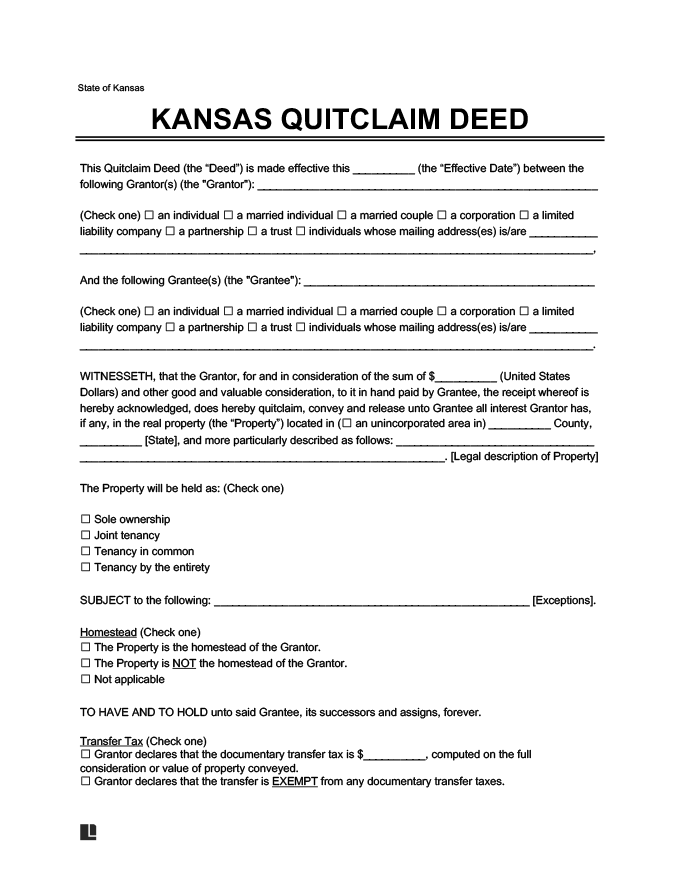When filing a quitclaim deed in Kansas, precision is critical. Follow these steps to avoid costly and inconvenient mistakes.
Step 1 – Procure a Copy of the Deed
The property owner should have a copy of the property deed. If not, you can request a copy from the county recorder’s office in the county where the property is situated. The legal description of the property is on the deed, so you will need the document before you proceed.
Step 2 – Transcribe the Legal Property Description
Pull the legal description from the existing deed and enter it into your Kansas quitclaim deed. A legal property description is typically described using section, township, and range, per the Kansas Register of Deeds Association [1]. The goal of the property description is to make it easy for a land surveyor or assessor to locate and identify the property.
Step 3 – Fill Out the Kansas Quitclaim Deed
Draft a Kansas quitclaim deed form using language similar to that provided under Kan. Stat. § 58-2204. While you can use the language provided, be sure to include the term “quitclaim” in the vesting clause. Your quitclaim deed should also indicate that the property is being transferred without warranty of title.
Failure to include the correct language can result in costly legal issues down the road. Consider downloading a fillable Kansas quitclaim form, you can simply fill in the blanks without overlooking important legal language.
Step 4 – Complete the Real Estate Sales Validation Questionnaire
When you transfer property using a quitclaim deed in Kansas, you may need to fill out a real estate sales validation questionnaire, per Kan. Stat. § 79-1437c. The questionnaire [2] can be completed by the buyer, seller, or an authorized agent of the buyer or seller. The goal of the document is to verify the amount of consideration paid for the conveyed property in compliance with Kan. Stat. § 79-1485, also called the Kansas Real Estate Ratio Study Act.
Exemptions from the real estate sales validation questionnaire requirement, per Kan. Stat. § 79-1437e, are as follows:
- Deeds releasing or securing security for a debt
- Deeds correcting or modifying a previously recorded deed without additional consideration
- Deeds as gifts, donations, or contributions
- Deeds for cemetery lots
- Deeds transferring property to or from a trust without consideration
- Deeds transferring property in a divorce settlement
- Deeds creating a joint tenancy or tenancy in common
If your deed is exempt from the validation questionnaire requirements, you must clearly state the exemption on the deed.
Step 5 – Sign the Quitclaim Deed Before a Notary
Real estate transfers via a quitclaim deed must be signed by the grantor, per Kan. Stat. § 58-2209. A quitclaim deed signed by the grantor is sufficient to convey property to the named recipient, according to Kan. Stat. § 58-2204. The Kansas Constitution, Art. 15 § 9 states that the grantor’s spouse must also sign the deed if it conveys a homestead property and the grantor is married.
The county recorder may accept an electronic signature instead of a physical signature if it meets requirements established in Kan. Stat. § 58-4403.
The grantor and their spouse, if applicable, must sign a Kansas quitclaim deed before a notary. The notary will complete, sign, and stamp an acknowledgment, per Kan. Stat. § 58-2211. If you sign the deed in the state of Kansas, you can also have it acknowledged by a register of deeds, county clerk, or mayor or clerk of an incorporated city.
Step 6 – File With the Register of Deeds
Once your Kansas quitclaim deed is completed, signed, and notarized, you can submit it to the register of deeds [3] in the county where the property is located. Per Kan. Stat. § 58-2221, the person filing the quitclaim deed must provide the grantee’s name and most recent mailing address to the recorder. The recorder will forward this information to the county clerk to ensure tax statements are sent to the new owner party.
Per Kan. Stat. § 58-2221, every deed conveying real estate property in Kansas must be registered with the register of deeds office in the county where the property is located [4]. The grantor or grantee who files the document must also provide the full name and mailing address of the grantee so they can receive tax statements for the property.
